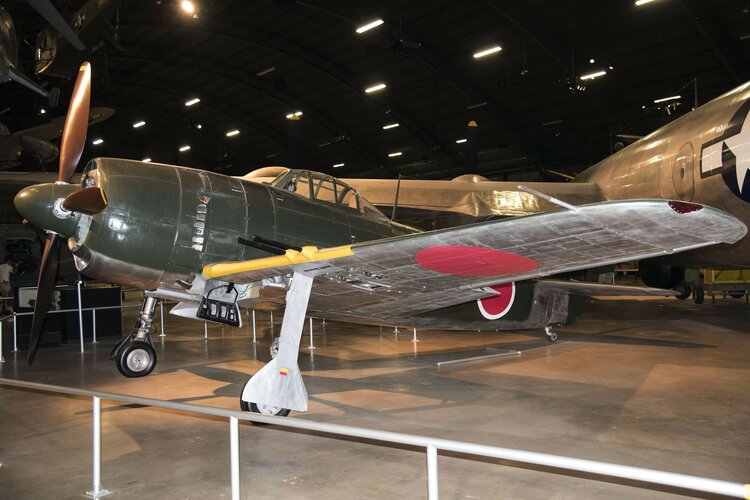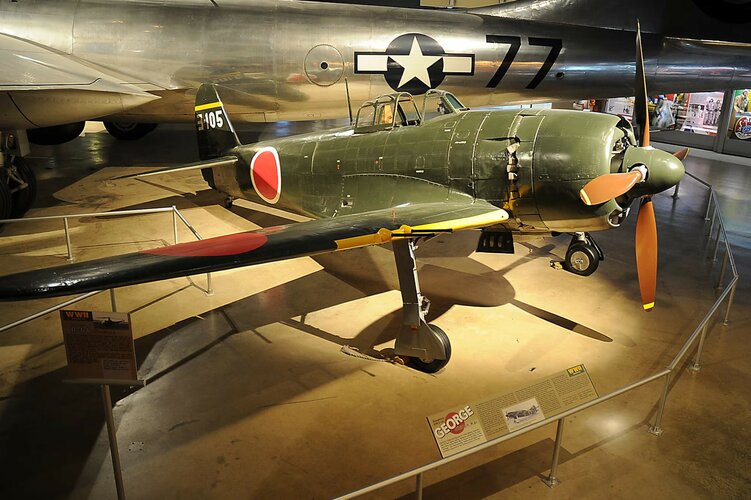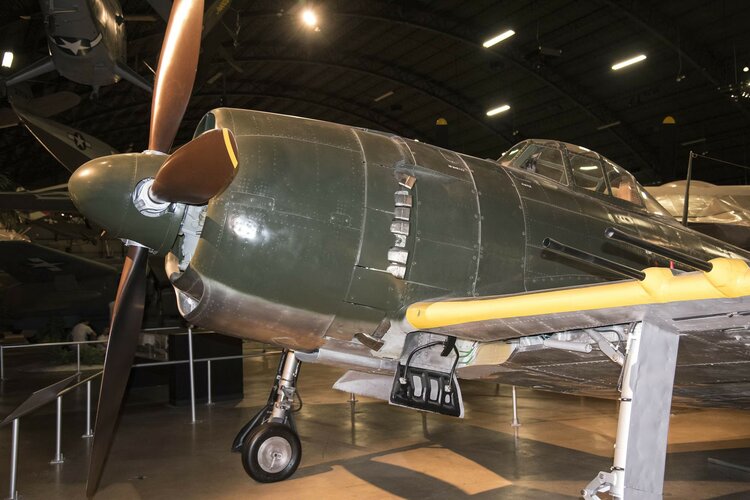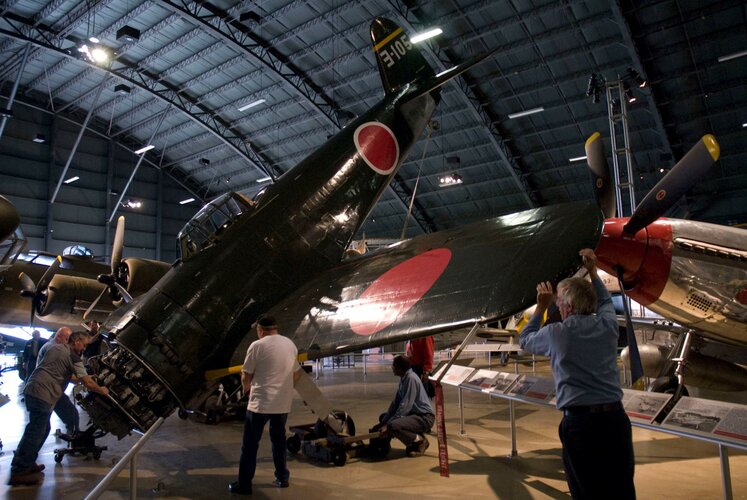- Kawanishi N1K2-J Shiden KAI
Designed in the spring of 1943 to succeed the
Shiden, the Kawanishi N1K2-J
Shiden KAI was its simplified version with a more reliable and similarly powerful engine that was 222 kg lighter. A total number of 23.000 parts were removed and it had a lower wing and simpler undercarriage.
These changes improved the chances to compete against the B-29 airplanes, although its armament of four 20 mm guns was somehow insufficient to destroy these gigantic machines. Thanks to the use of Type 3 Number 6 Mark 27 Model 1, with 60 kg rocket bombs - launched from rails installed under the wings - but also through ramming attacks, the
Shiden KAI was able to shoot down some of the
Superfortress.
On 7 April the B-29 42-63512 was rammed over Tokyo by a KAI of the 301
st Kokutai. Between 18 April 18 and 11 May 1945 the
Shiden KAIs of the 343
rd Kokutai performed 120 interception operations against the B-29 that were striking the
kamikaze bases of Oita, Tachiarai, Kanoya and Chiran, to the South of Kyushu. On April 22, two KAIs of the 407
th Kokutai shot the belly of an unidentified B-29 at 8,000 m over Kanoya. The bomb bay exploded as a result and the three airplanes were destroyed.
On 5 May two B-29 bombers, with numbers 42-65305 and 44-69899, were shot down by
Shiden KAIs of the 343
rd Kokutai over Oita, one by the rocket-bombs and the other by ramming. On May 7, the 42-63549 and the 44-69887 B-29 were also destroyed over the same place and following same pattern of attack.
During the combats of these days, three KAIs of the 343
rd Kokutai were shot down by the machine guns of the B-29 bombers, seven by forced landing and fifteen by bombing. At medium altitude fighting, the KAI was more efficient than the
Shiden, a serious opponent to the Mustang under 4,000 m and to the Corsair at low level. On June 22, 1945 one KAI of the 343
rd Kokutai rammed the
Corsair FG-1D BuNo.88441 in a fight over Amami Oshima.
A total of just 428
Shiden KAIs were manufactured to be used by the elite units. The
KAI was too valuable to be used in suicide missions, but during the Okinawa battle the IJN lost 29 aircrafts against the U.S. Navy fighters while escorting
kamikaze groups.
By mid-1943, the effective blockade by the U.S. Navy Submarine Force began to strangle the Japanese economy and the aeronautical industry was particularly affected by increasing shortages of high aviation fuel and light alloys. On 8 September, Nakajima, Tachikawa and Mansyu were instructed by the IJA to use wood and steel as aluminium substitutes in the manufacture of the
Hayate fighter.
In the version Ki.113, designed in the fall of 1944, Nakajima used steel in as many sub-assemblies as possible, but the excessive weight of the new airframe caused the abandoning of the project after the completion of the prototype early in 1945. Kawanishi proposed the construction of the N1K5-J, a steel version of the
Shiden-KAI with 13.92 m extended wingspan, powered by one Mk 9A engine, but the project was dismissed because of excessive weight.
The IJN ‘20-shi-Ko’ specification
The ‘20-shi-Ko’ is just an expression used by some authors to to refer to the IJN 23 May 1945 requirement for the future air-superiority fighter, that it was supposed to have entered service in 1947. In fact, the IJN terminated to use the ‘shi’ naming system for experimental aircraft in 1943 (Showa 18).
After this decision, experimental aircraft names were such as ‘Experimental
Shiden-KAI’ or ’Experimental
Reppu-KAI’. The IJN used the ‘shi’ specification system for the last time in 1942, calling for a ‘17-shi-Ko’ air-superiority carrier fighter (Mitsubishi M-50, A7M1
Reppu) and for the ‘17-shi-Otsu’ interceptor fighter (Kawanishi K-90, J3K
Shiden 31 and Mitsubishi M-70, J4M
Senden).
The ‘18-shi-Otsu’ 1943 interceptor fighter specification (Nakajima J5N
Tenrai, Kawanishi J6K
Jinpu and Kyushu J7W
Shinden) and the ‘20-shi-Ko’ 1945 air-superiority fighter specification (Mitsubishi A8M, Kawanishi A8K and Nakajima A8N) exist only in specialised literatures as ‘historic license’. The official definition of the IHN for the 1945 air-superiority fighter was just ‘Next air-superiority Ko fighter’.
The 23 May 1945 specification requirements were for a maximum speed de 704 kph at 10,000 m, landing speed below 148 kph, 15 minutes to reach 10,000 m altitude, 13,500 m service ceiling, 2.5 hours endurance, four 20 mm cannons with 250 rounds per gun, self-sealing fuselage tanks, automatic extinguish device for the wings tanks, armour protection for the pilot and automatic combat flaps. Mitsubishi, Kawanishi and Nakajima submitted several projects based on the
Reppu, the
Jinpu, the
Shiden-KAI and the Ki.87-II.
Kawanishi
To meet the requirements of the 17-shi-Otsu IJN specification, calling for a high-performance, land-based,
Kyokusen interceptor, Kawanishi proposed its project K 90, with Nakajima
Homare engine, in 1942.
The IJN ordered the development of the K 90, as J3K1, powered by one Mitsubishi MK9B (Ha-43-21) engine with two-stage mechanical supercharger and Vulkan coupling drive first stage. In August 1943, the project was modified as J6K1
Jinpu, to adapt it to the ‘18-shi-Ko’ specification, calling for a high-altitude, air-superiority fighter powered by one Nakajima NK9A-O
Homare 40, two-stage, three-speed mechanical supercharged engine, with intercooler, forced cooling fan and oxygen injection.
In July 1944, the J6K1 was superseded by the N1K2-J
Shiden-KAI that was chosen by the
Kaigun Koku Hombu for large-scale production. In April 1945, Kawanishi proposed the modification of the J6K1 to the IJN to adapt it to the requirements of the ‘20-shi-Ko’ specification, to be powered by an Ha-44-21 engine with intercooler and forced cooling fan and an armament of six Type 99, Model 2/5, 20 mm cannon. According to some authors, the new design was named A8K1
Toppu.
A8K1 technical data
Wingspan: 12.5 m, length: 10.118 m, height: 3.94 m, wing area: 26 sq.m, max weight: 4,373 kg, max speed: 685 kph, ceiling: 13,000 m.
Along with the A8K1, Kawanishi submitted the ‘High-Performance
Shiden-KAI’ project that basically was a N1K5-J
Shiden 25 powered by one 2,200 hp Nakajima Ha-45-44 engine, with two-stage, three-speed mechanical supercharger, intercooler and six Type 99, Model 2/5, 20 mm cannon.
‘High-Performance Shiden-KAI’ technical data
Wingspan: 11.99 m, length: 9.346 m, height: 3.96 m, wing area: 23.5 sq.m, max weight: 4,768 kg, max speed: 663 kph, ceiling: 12,000 m.
















